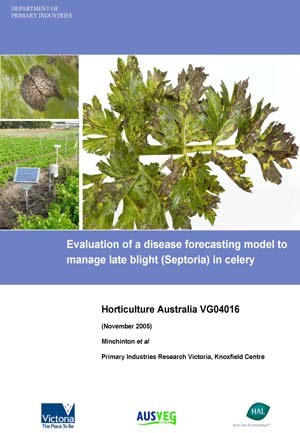|
|
This project details the outcomes of a 12-month study of late blight of celery which investigated efficacy and economics of the TomCast disease forecasting model for timing fungicide sprays to control late blight without reducing quality or yield. Celery (Apium graveolens) is a crop that needs to be intensively managed due to exceedingly high aesthetic standards required and low damage thresholds. Late blight, caused by the fungus Septoria apiicola Speg., is a major foliage disease of celery. The high disease pressure from late blight in commercial celery crops is managed by weekly spraying with contact fungicide sprays, up to 16 times after transplanting. Growers are keen to reduce pesticide applications to minimise production costs, even if by only one spray. The public is also demanding fewer pesticides and less contamination of the environment.
Research has evaluated a computer model that can reduce the number of sprays for control of late blight in celery. Late blight is a fungal disease that attacks leaves and stalks of celery crops as they mature. Celery is usually sprayed weekly to control late blight, which can results in up to16 sprays being applied per crop. The model showed that savings on sprays could be made in the early stages of crop production, before the plant canopy closed in. Most savings were made on winter crops. The model predicted a saving of 7-8 sprays on winter crops and 3-5 sprays on summer crops but only in the early growth stages. The model is called TomCast and it uses weather data to forecast the appearance of late blight in crops. Temperature and leaf wetness data are collected by a weather station positioned in the crop and fed into a computer-based model. The model determines when to spray and when not to spray for late blight. If conditions were favourable for late blight and provided no sprays had been used in the last 7 days, then a spray should be applied. If conditions were not favourable for late blight then the model shows that no sprays should be applied. Major findings:
Research by scientists at DPI’s Knoxfield Centre was supported by funds from the Vegetable Industry, Horticulture Australia, the Department of Primary Industries Victoria and the Federal Government. |
||||||||
|

